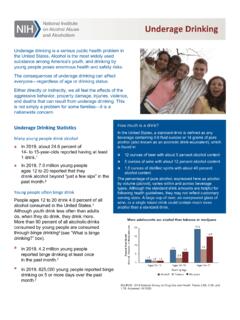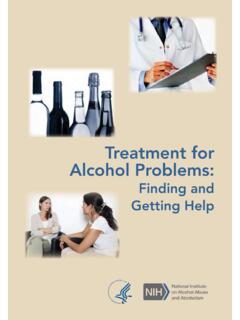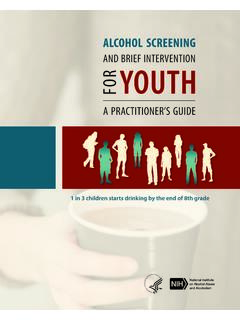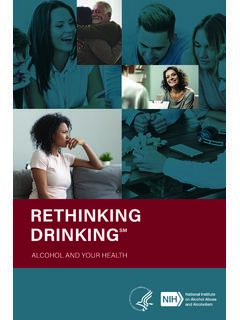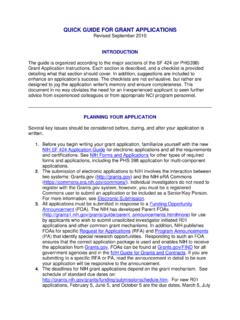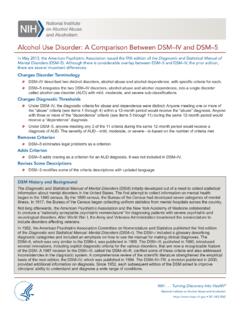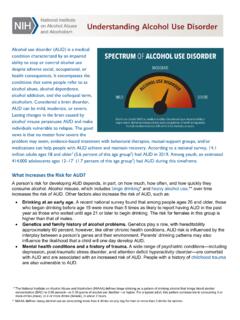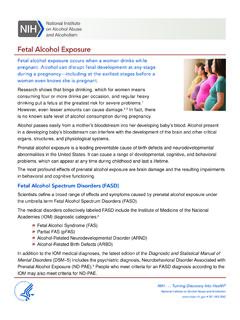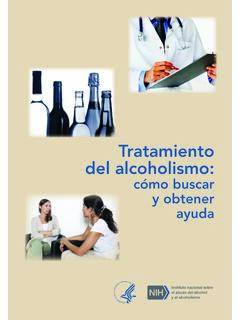Transcription of Alcohol Facts and Statistics Fact Sheet
1 NIH .. Turning Discovery Into Health National Institute on Alcohol Abuse and 301 443 3860 Alcohol Facts and StatisticsAlcohol Use in the United States: Prevalence of drinking : According to the 2018 National Survey on Drug Use and Health (NSDUH), percent of people ages 18 or older reported that they drank Alcohol at some point in their lifetime; percent reported that they drank in the past year; percent reported that they drank in the past Prevalence of Binge drinking and Heavy Alcohol Use: In 2018, percent of people ages 18 or older reported that they engaged in binge drinking in the past month; percent reported that they engaged in heavy Alcohol use in the past (See sidebar on page 2 for definitions of binge drinking and heavy Alcohol use.)
2 Alcohol Use Disorder (AUD) in the United States: Adults (ages 18+): According to the 2018 NSDUH, million adults ages 18 and older2 ( percent of this age group3) had AUD. This includes million men2 ( percent of men in this age group3) and million women2 ( percent of women in this age group3). About percent of adults who had AUD in the past year received treatment. This includes percent of males and percent of females with AUD in this age Youth ages 12 to 17: According to the 2018 NSDUH, an estimated 401,000 adolescents ages 12 172 ( percent of this age group3) had AUD. This number includes 173,000 males2 ( percent of males in this age group3) and 227,000 females2 ( percent of females in this age group3). About percent of youth who had AUD in the past year received treatment.
3 This includes percent of males and percent of females with AUD in this age Deaths: An estimated 88,0005 people (approximately 62,000 men and 26,000 women5) die from Alcohol -related causes annually, making Alcohol the third leading preventable cause of death in the United States. The first is tobacco, and the second is poor diet and physical In 2014, Alcohol -impaired driving fatalities accounted for 9,967 deaths (31 percent of overall driving fatalities).7 NIH .. Turning Discovery Into Health National Institute on Alcohol Abuse and 301 443 3860 Economic Burden: In 2010, Alcohol misuse cost the United States $ Three-quarters of the total cost of Alcohol misuse is related to binge Burden: In 2012, million deaths, or percent of all global deaths ( percent for men and percent for women), were attributable to Alcohol In 2014, the World Health Organization reported that Alcohol contributed to more than 200 diseases and injury-related health conditions, most notably DSM IV Alcohol dependence (see sidebar), liver cirrhosis, cancers, and In 2012, percent of the burden of disease and injury worldwide (139 million disability-adjusted life-years) was attributable to Alcohol Globally, Alcohol misuse was the fifth leading risk factor for premature death and disability in 2010.
4 Among people between the ages of 15 and 49, it is the In the age group 20 39 years, approximately 25 percent of the total deaths are Alcohol Consequences: More than 10 percent of children live with a parent with Alcohol problems, according to a 2012 drinking : Prevalence of underage Alcohol Use: Prevalence of drinking : According to the 2018 NSDUH, percent of 15-year- olds report that they have had at least 1 drink in their About million people ages 12 2015 ( percent of this age group16) reported drinking Alcohol in the past month ( percent of males and percent of females16).DefinitionsAlcohol Use Disorder (AUD): AUD is a chronic relapsing brain disease characterized by an impaired ability to stop or control Alcohol use despite adverse social, occupational, or health consequences.
5 AUD can range from mild to severe, and recovery is possible regardless of severity. The fourth edition of the Diagnostic and Statistical Manual of Mental Disorders (DSM IV), published by the American Psychiatric Association, described two distinct disorders Alcohol abuse and Alcohol dependence with specific criteria for each. The fifth edition, DSM 5, integrates the two DSM IV disorders, Alcohol abuse and Alcohol dependence, into a single disorder called Alcohol use disorder, or AUD, with mild, moderate, and severe drinking : NIAAA defines binge drinking as a pattern of drinking that brings blood Alcohol concentration (BAC) levels to g/dL. This typically occurs after 4 drinks for women and 5 drinks for men in about 2 The Substance Abuse and Mental Health Services Administration (SAMHSA), which conducts the annual National Survey on Drug Use and Health (NSDUH), defines binge drinking as 5 or more alcoholic drinks for males or 4 or more alcoholic drinks for females on the same occasion ( , at the same time or within a couple of hours of each other) on at least 1 day in the past Alcohol Use: SAMHSA defines heavy Alcohol use as binge drinking on 5 or more days in the past of drinking Associated with AUD: Binge drinking and heavy Alcohol use can increase an individual s risk of AUD.
6 The Dietary Guidelines recommend that if Alcohol is consumed, it should be in moderation, defined as up to one drink per day for women and up to two drinks per day for men, and only by adults of legal drinking age. Some individuals should avoid Alcohol Fatality: A fatality in a crash involving a driver or motorcycle rider (operator) with a BAC of g/dL or Life-Years (DALYs): A measure of years of life lost or lived in less than full drinking : Alcohol use by anyone under the age of 21. In the United States, the legal drinking age is .. Turning Discovery Into Health National Institute on Alcohol Abuse and 301 443 3860 Prevalence of Binge drinking : According to the 2018 NSDUH, approximately million people15 (about percent16) ages 12 20 ( percent of males and percent of females16) reported binge drinking in the past month.
7 Prevalence of Heavy Alcohol Use: According to the 2018 NSDUH, approximately 861,000 people15 (about percent16) ages 12 20 ( percent of males and percent of females16) reported heavy Alcohol use in the past month. Consequences of underage Alcohol Use: Research indicates that Alcohol use during the teenage years could interfere with normal adolescent brain development and increase the risk of developing AUD. In addition, underage drinking contributes to a range of acute consequences, including injuries, sexual assaults, and even deaths including those from car and College Students: Prevalence of Alcohol Use: Prevalence of drinking : According to the 2018 NSDUH, percent of full-time college students ages 18 22 drank Alcohol in the past month compared with percent of other persons of the same Prevalence of Binge drinking : According to the 2018 NSDUH, percent of college students ages 18 22 reported binge drinking in the past month compared with percent of other persons of the same Prevalence of Heavy Alcohol Use.
8 According to the 2018 NSDUH, percent of college students ages 18 22 reported heavy Alcohol use in the past month compared with percent of other persons of the same Consequences Researchers estimate that each year: 1,825 college students between the ages of 18 and 24 die from Alcohol -related unintentional injuries, including motor-vehicle 696,000 students between the ages of 18 and 24 are assaulted by another student who has been 97,000 students between the ages of 18 and 24 report experiencing Alcohol -related sexual assault or date Roughly 20 percent of college students meet the criteria for About 1 in 4 college students report academic consequences from drinking , including missing class, falling behind in class, doing poorly on exams or papers, and receiving lower grades and Pregnancy.
9 The prevalence of Fetal Alcohol Syndrome (FAS) in the United States was estimated by the Institute of Medicine in 1996 to be between and cases per 1, More recent reports from specific sites report the prevalence of FAS to be 2 to 7 cases per 1,000, and the prevalence of Fetal Alcohol Spectrum Disorders (FASD) to be as high as 20 to 50 cases per 1, ,25 NIH .. Turning Discovery Into Health National Institute on Alcohol Abuse and 301 443 3860 Alcohol and the Human Body: In 2018, of the 83,517 liver disease deaths among individuals ages 12 and older, percent involved Alcohol . Among males, 52,499 liver disease deaths occurred and percent involved Alcohol . Among females, 31,018 liver disease deaths occurred and percent involved Among all cirrhosis deaths in 2013, percent were Alcohol related.
10 The proportion of Alcohol -related cirrhosis was highest ( percent) among deaths of persons ages 25 34, followed by deaths of persons ages 35 44, at In 2009, Alcohol -related liver disease was the primary cause of almost 1 in 3 liver transplants in the United drinking Alcohol increases the risk of cancers of the mouth, esophagus, pharynx, larynx, liver, and more information, please visit: Substance Abuse and Mental Health Services Administration (SAMHSA). 2018 National Survey on Drug Use and Health (NSDUH). Table Tobacco Product and Alcohol Use in Lifetime, Past Year, and Past Month among Persons Aged 12 or Older, by Age Group: Percentages, 2017 and 2018. Available at: #tab2-1b. Accessed 12/2 SAMHSA. 2018 National Survey on Drug Use and Health (NSDUH).
